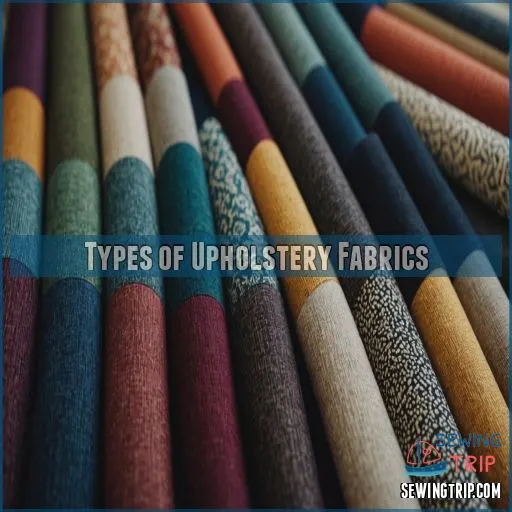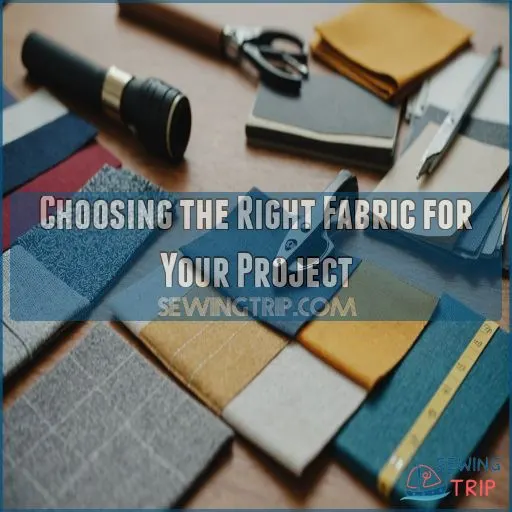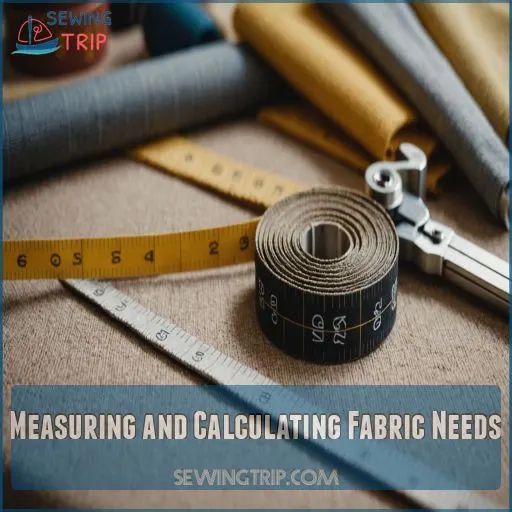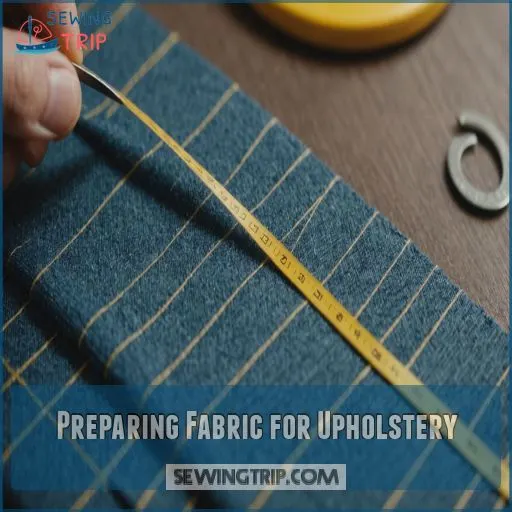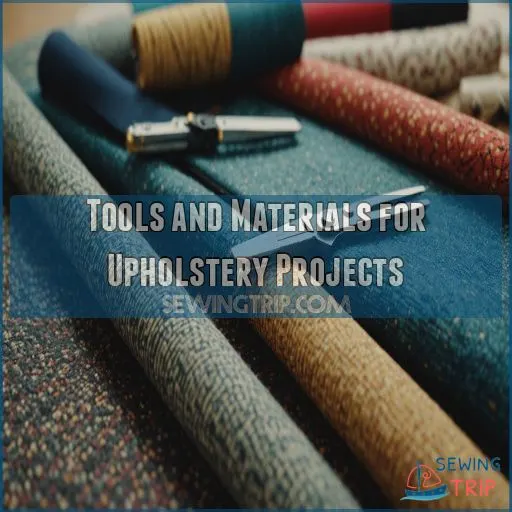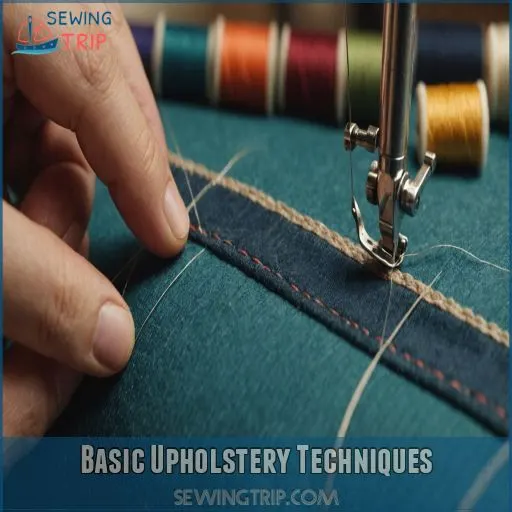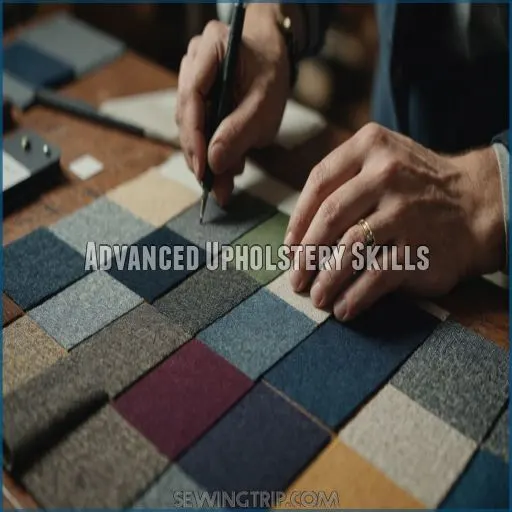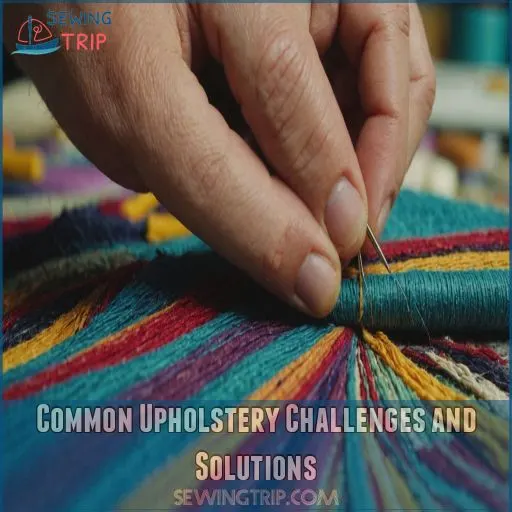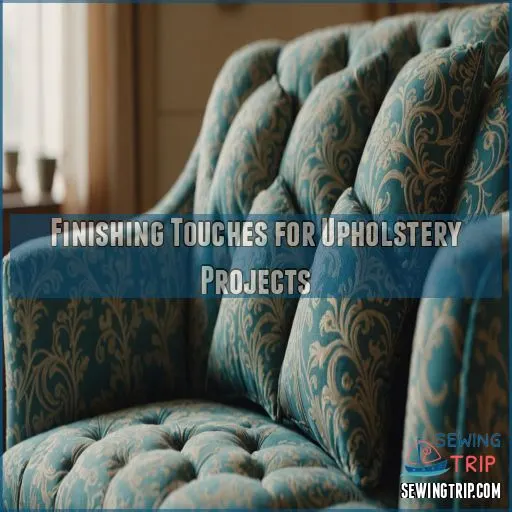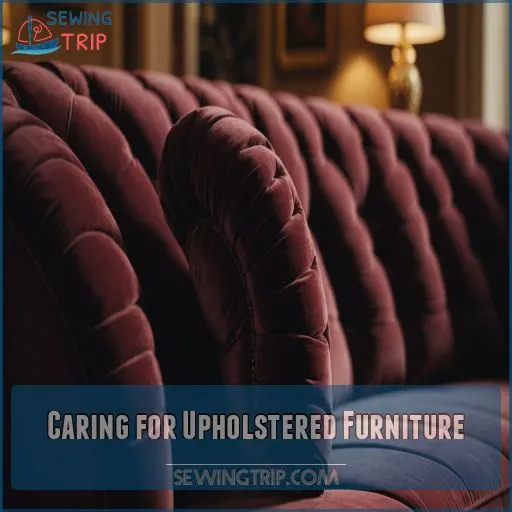This site is supported by our readers. We may earn a commission, at no cost to you, if you purchase through links.
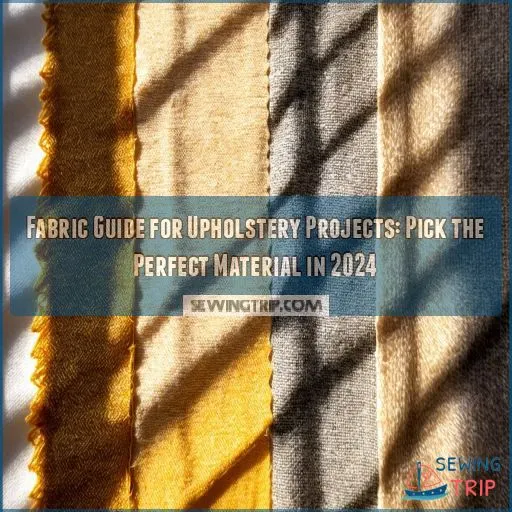
Start by understanding different fabric types: natural fabrics like cotton breathe well, while synthetics like polyester are durable and easy to clean. Blends offer the best of both worlds.
Consider where and how you’ll use your furniture—durability is key for high-traffic areas, and style should match your decor.
Don’t forget to calculate fabric needs carefully, considering pattern repeats and seam allowances.
Next, explore tools and materials that will streamline your project.
Ready to discover more upholstery secrets?
Table Of Contents
- Key Takeaways
- Types of Upholstery Fabrics
- Choosing The Right Fabric for Your Project
- Measuring and Calculating Fabric Needs
- Preparing Fabric for Upholstery
- Tools and Materials for Upholstery Projects
- Basic Upholstery Techniques
- Advanced Upholstery Skills
- Common Upholstery Challenges and Solutions
- Finishing Touches for Upholstery Projects
- Caring for Upholstered Furniture
- Frequently Asked Questions (FAQs)
- Conclusion
Key Takeaways
- You should choose your fabric based on the type of project, considering durability, breathability, and style; natural fabrics like cotton and wool offer breathability, while synthetics like polyester provide durability.
- Always measure and calculate your fabric needs accurately. Don’t forget to consider pattern repeats and seam allowances to avoid running short on materials.
- Protect and maintain your upholstery by using fabric protectors for stain resistance, and practice regular cleaning methods to keep your furniture looking fresh.
- When working with challenging shapes or patterns, plan your fabric placement carefully to ensure seamless designs and avoid mismatched patterns.
Types of Upholstery Fabrics
You’ll find a wide array of upholstery fabrics to suit your project, from natural options like cotton and linen to synthetics such as polyester and microfiber.
Each type has its own unique properties, so you’ll want to weigh factors like durability, maintenance, and style when making your choice.
Natural Fabrics
The allure of natural fabrics for your upholstery project is undeniable.
You’ll find cotton, linen, and silk among your top choices, each offering unique benefits.
Cotton breathes well and has a natural look, while linen blends provide durability and style, and wool is also extremely durable and resists fading.
Silk adds a touch of luxury.
For more on natural fabric options like wool and their characteristics, see natural upholstery fabric types.
Remember, ethical sourcing matters too.
When selecting natural fibers, consider fabric lifespan and stain resistance to make sure your upholstery lasts.
Synthetic Fabrics
From polyester to nylon, synthetic fabrics offer a world of possibilities for your upholstery projects.
You’ll find these man-made materials pack quite a punch:
- Durability: Resist wear and tear like a champ
- Easy cleaning: Stain-resistant properties make maintenance a breeze
- Affordability: Often more budget-friendly than natural alternatives
- Versatility: Available in countless colors and textures
With synthetic fabrics, you’re in control of your upholstery’s look and performance.
They’re a smart choice for busy households seeking long-lasting, low-maintenance solutions.
Blended Fabrics
Synthetic fabrics shine with durability, yet blending materials can add unique benefits to your upholstery projects.
By mixing cotton with polyester, you gain the breathability of cotton and the resilience of polyester.
Blends for durability offer a cost-effective, stylish choice for your sofa slipcover or DIY upholstery.
Consider blend care and cost to strike the perfect balance.
Specialty Fabrics
Specialty fabrics for upholstery projects cater to unique needs, such as performance fabrics for active homes.
Consider:
- Outdoor fabrics: Durable and weather-resistant, perfect for patio furniture.
- Fire-retardant fabrics: Ideal for safety-conscious spaces, reducing fire risks.
- Stain-resistant fabrics: Essential for families and pet-friendly homes, making spills less of a hassle.
With these, your fabric project’s quality and practicality can truly shine.
Choosing The Right Fabric for Your Project
Selecting the ideal fabric for your upholstery project involves balancing durability, aesthetics, and maintenance needs, all while staying within your budget.
Consider how factors like daily wear, style preferences, and environmental conditions, such as sunlight exposure, might impact your choice.
Durability Considerations
For upholstery, durability is key.
Look for fabrics with a high double rub rating, like microfiber or canvas, to make sure your furniture can withstand daily wear and tear.
Pay attention to the rub count – anything over 15,000 is ideal for heavy-use pieces.
Investing in quality materials will save you time and money in the long run.
Aesthetics and Style
Selecting a fabric that complements your home’s aesthetics can transform a room effortlessly.
Mix color palettes with current design trends to breathe life into your space.
Consider fabric patterns that echo style inspiration from magazines or online galleries.
Remember, fabric isn’t just a backdrop; it’s the main event, anchoring the room’s overall aesthetics and harmonious atmosphere.
Maintenance Requirements
As you balance aesthetics with practicality, remember maintenance matters too.
High fabric durability and stain resistance are key.
Check cleaning codes for guidance—some fabrics like Code X need gentle vacuuming, others tolerate water-based cleaners.
Employ fabric protectors to extend upholstery lifespan, ensuring your project remains fresh and inviting without constant upkeep.
Choose wisely for a lasting, effortless look.
Budget Constraints
You’ve considered maintenance; now, let’s look at budget constraints.
Affordable fabric options let you get creative without breaking the bank.
When calculating fabric costs, consider the width of the fabric to make sure you’re getting the best value for your project.
Explore budget-friendly DIY with cost-effective materials like secondhand fabric.
Hunt for fabric shopping tips at thrift stores to find hidden gems at a fraction of the cost.
Your wallet will thank you, and so will your creativity!
Environmental Factors
When choosing upholstery fabric, consider environmental factors that affect your home.
Look for eco-friendly options and pay attention to:
- Sustainable sourcing practices
- Impact on indoor air quality
- Durability and longevity
- Ease of material disposal
- Reduction of your carbon footprint
Prioritize these aspects for a more sustainable and healthier living space, ensuring your project aligns with ecological goals.
Measuring and Calculating Fabric Needs
To make sure you purchase the right amount of fabric for your upholstery project, accurately measure each piece of furniture and account for pattern repeats and seams.
Fabric calculators help you avoid costly mistakes and makes sure you have enough material to cover any surprises.
Measuring Furniture Pieces
Picking the right fabric is just the start.
Now, let’s measure your furniture with precision.
Grab a tape measure and jot down dimensions of cushions, frames, and sides.
Remember, fabric allowance is key—add extra inches for seams.
Accurate measurements prevent costly surprises later.
With these tools, you’ll confidently calculate your upholstery needs.
Accounting for Pattern Repeats
If your fabric has a pattern, be sure to account for the repeat size when calculating yardage.
Measure the full repeat distance and add extra fabric to match the pattern across seams.
This will minimize waste and guarantee a cohesive, professional look for your upholstery project.
Adding Extra for Seams and Mistakes
Planning your upholstery project? Always add extra yardage for seams and unexpected slips.
Avoid fabric waste by accounting for:
- Seam allowances, usually about an inch on all sides.
- Pattern matching needs.
- At least 10% extra for mistakes.
- Welting, if you’re including it in the design.
Remember, mistakes happen, and a little extra can save the day.
Using Fabric Calculators
Embracing the digital age, a fabric calculator is your best friend for accurate yardage estimation, ensuring you don’t buy too much or too little.
Online tools simplify this task, turning measurements into a clear project cost, ultimately saving you money.
Whether you’re tackling a sofa or a chair, precise calculations help prevent fabric mishaps and overbuying.
Preparing Fabric for Upholstery
Properly preparing your fabric for upholstery involves several key steps to guarantee a professional finish.
You’ll want to pre-wash to prevent shrinkage.
You’ll also want to iron out wrinkles for a smooth surface.
Consider treatments to protect against stains and wear.
Pre-washing and Shrinkage
Before cutting comes washing—use the right pre-washing techniques to avoid fabric shrinkage surprises later.
Test a small piece with your usual wash routine, focusing on water temperature and fabric care.
This method helps minimize shrinkage and better adherence to your measurements (Source).
It’s like a fabric insurance policy, sparing you from future snug fits.
Ironing and Pressing
Once pre-washing is complete, it’s time to iron those fabrics for a smooth start.
Use the right ironing techniques based on fabric types and decide between steam or dry methods.
Here’s what you’ll need:
- Pressing tools: Choose wisely for wrinkle removal.
- Heat settings: Tailor to each material.
- Steaming options: Understand your fabric’s needs.
Cutting and Pattern Matching
Align everything perfectly by mastering cutting and pattern matching for upholstery.
Use precise cutting tools and account for nap direction to minimize fabric waste.
Always consider pattern repeats when marking seam allowances; this makes sure the patterns flow seamlessly across the project.
Taking these steps guarantees your finished piece looks professionally crafted and maintains a harmonious design throughout.
Fabric Treatments and Protectors
Safeguard your upholstery with fabric protectors that shield against spills, stains, and UV damage.
Options like GreenGard, FabArmor, and FabGard offer stain resistance, moisture-wicking, and even fire retardancy.
For delicate fabrics, solvent-based treatments like FabGard provide discreet protection.
Explore pre-treatment services to make sure your fabrics stay looking fresh and new.
Tools and Materials for Upholstery Projects
When you’re tackling an upholstery project, you’ll need the right tools and materials to get the job done effectively.
From essential hand tools and sewing machines to staple guns and padding, understanding what each item does will set you up for success.
Essential Hand Tools
Effective upholstery starts with high-quality tools.
Make sure you have these essentials:
- Fabric shears for clean cuts.
- An upholstery needle for precise stitching.
- A sturdy hammer for installing tacks.
- Pliers to remove stubborn staples.
- A measuring tape for accuracy.
These tools transform your projects from ordinary to extraordinary.
Sewing Machines and Attachments
You’ve got your hand tools ready, now let’s explore sewing machines and attachments.
Different types of sewing machines cater to various upholstery needs.
Pairing the right needle selection and foot types is important.
Here’s a quick table:
| Feature | Description | Tip |
|---|---|---|
| Sewing Machine | Choose type based on fabric | Match needle to fabric type |
| Attachments | Essential for complex tasks | Keep attachments handy |
| Troubleshooting | Fix common jams easily | Regular maintenance matters |
Sew smart!
Staple Guns and Fasteners
Without a doubt, choosing the right staple gun for upholstery is important.
From manual, electric to pneumatic types, each offers unique features for fastener sizes and upholstery staples.
Prioritize safety tips and regular staple gun maintenance to guarantee effective use.
Manual guns need muscle while electric models offer ease.
Perfect those fabric layers effortlessly!
Padding and Stuffing Materials
Ready to enhance your upholstery projects?
Explore padding and stuffing materials like foam and fiberfill.
Foam offers great support, while fiberfill provides a softer touch.
Consider foam’s density to make sure comfort, and don’t overlook sustainable options if you’re eco-conscious.
For a personal touch, try creating your own DIY padding.
Remember, choosing the right material impacts the final product’s feel and durability.
Basic Upholstery Techniques
When tackling basic upholstery techniques, you’ll start by expertly removing the old fabric, reinforcing frames, and applying fresh padding to make sure longevity and comfort.
Next, with staple gun in hand, firmly attach the new fabric, giving your furniture a revitalized appearance.
Removing Old Fabric
Before tackling the new fabric, you’ll need to carefully remove the old.
Start by taking detailed photos to remember the order.
Use a screwdriver and pliers to pry out staples, tacks, or flexible tack strip holding the fabric in place.
Work slowly and methodically to preserve the old fabric as a template for your new project.
Repairing and Reinforcing Frames
Tackling frame repairs in upholstery projects requires understanding wood types and joint strengthening.
Use long-grain plugs for sturdy reinforcement, ensuring frame stability with glue and screws.
For a more polished finish, consider using techniques like edge binding for leather to secure and hide seams.
Opt for hardwoods like oak or maple for critical sections.
Utilize reinforcement methods like corner brackets to fortify joints effectively.
Remember, a well-repaired frame is the backbone of durable, comfortable furniture.
Applying New Padding
After fixing those wobbly frames, it’s time for fresh padding. Choose the right padding type to suit your project needs for comfort and durability. Use appropriate tools to make sure even placement and thickness for that perfect feel.
- Foam Varieties: High density, medium density, etc.
- Thickness Options
- Strategic Placement
- Padding Tools
- Techniques for Evenness
Attaching Fabric With Staples or Tacks
Consider using a staple gun to secure your fabric with precision.
Choose the right type for your project, ensuring even staple placement for smooth results.
Tack strips can provide clean edges and hold fabric tension effectively.
Keep upholstery tools like a staple remover handy for adjustments.
Mastering this technique enhances your upholstery skills, giving you freedom to create.
Advanced Upholstery Skills
As you advance your upholstery skills, you’ll learn essential techniques like creating tufted designs, sewing precise piping and welting, and crafting custom slipcovers.
Mastering these skills will allow you to work confidently with various challenging materials, including leather and vinyl.
Enhancing both the aesthetics and durability of your projects.
Creating Tufted Designs
Once you’ve mastered basic upholstery techniques, creating tufted designs adds a stylish flair.
Choose tufted fabric wisely—opt for durable options like heavy canvas or duck cloth, which work well with denim needles for a smooth finish as shown in the guide on how to sew upholstery.
Patterns like diamond or biscuit offer visual appeal, while button types range from simple to ornate.
Essential tufting tools include a staple gun and upholstery needles.
Explore the rich tufted upholstery history for inspiration in your design process.
Sewing Piping and Welting
Tufted designs add charm, but piping techniques and welting styles bring sophistication to your upholstery projects.
Choose fabric wisely; it transforms simple piping into a striking accent.
Gather tools needed, like sewing machines and cording.
Experiment with project ideas, ensuring welting aligns neatly with edges.
Mastering these skills elevates your work from good to wow, creating unique, custom pieces.
Making Slipcovers
Slipcovers are a versatile way to transform your furniture.
To get the perfect fit, consider these tips:
- Choose a fabric with a bit of stretch, like cotton or linen blends, for a snug, custom look.
- Opt for a railroaded fabric to minimize seams and create a seamless design.
- Measure carefully, allowing extra for pleats and tucks, to make sure a polished, custom appearance.
Working With Leather and Vinyl
When diving into leather and vinyl upholstery, you’ll need to balance leather care with vinyl durability.
For leather, keep it conditioned and dry; vinyl demands less fuss but choose wisely on high-wear furniture.
Use upholstery tools effectively for these DIY projects, and remember:
| Material | Key Focus |
|---|---|
| Leather | Regular care |
| Vinyl | High durability |
Common Upholstery Challenges and Solutions
When tackling upholstery projects, you might face common challenges like awkward shapes and pattern matching that can seem intimidating.
With a few practical solutions, you’ll overcome issues like sagging springs and fabric tears, making your furniture look refreshed and inviting.
Dealing With Awkward Shapes
Curved furniture and awkward shapes can be a real headache in upholstery projects.
Tackling angles and corners is simpler with these tips:
- Stretch fabric tightly around corners, making small slits for a smoother fit.
- Use batting to create a seamless cushion feel.
- Securely staple and periodically check alignment for clean lines.
Matching Patterns Across Seams
Achieving perfect pattern alignment across seams involves careful seam placement and understanding fabric repeats.
Always start by planning how stripes or patterns will meet.
It’s like solving a complex puzzle—each piece must fit just right.
Focus on direction to avoid mismatched patterns, ensuring a seamless look.
Use the following table for a visual guide:
| Key Element | Tips | Example |
|---|---|---|
| Pattern Alignment | Lay fabrics with precision | Stripes line up |
| Seam Placement | Pin and check alignment | Corners match |
| Fabric Repeats | Calculate pattern repeat | Consistent design |
Fixing Sagging Springs
Spotting sagging springs? Don’t fret!
First, identify the spring types – zigzag or coil.
You might need spring repair or even a spring replacement to tighten the sagging tension.
For effective sagging prevention, consider using webbing stretched taut but not overly so.
Align the springs properly using clips to maintain shape and provide long-lasting comfort (Source).
Repairing Tears and Holes
Imagine this: your beloved couch has a tear, but don’t panic!
Grab some fabric scraps and iron-on patches for a quick DIY patching fix.
Using a curved needle, deftly sew the edges together with strong thread.
For a seamless finish, apply fabric glue to secure frayed bits.
These upholstery fixes will have your furniture looking spiffy in no time.
Finishing Touches for Upholstery Projects
Don’t forget the finishing touches! Add decorative trims, buttons, and studs to really make your upholstery project shine.
And don’t forget to create custom cushions and apply any final fabric treatments for a polished, professional look.
Adding Decorative Trims
Overcoming upholstery challenges brings you to finishing touches, like adding decorative trims.
Choose trim types such as gimp or fringe to fit your style.
Consider trim placement along edges and corners for visual appeal.
Use durable trim materials, ensuring a secure installation.
Explore various trim styles to complement the fabric and create a polished, refined look.
Applying Buttons and Studs
With trims adding flair, consider the artistry of applying buttons and studs.
Perfect button placement and stud spacing require a few essential tools.
Here’s your quick guide:
- Button placement for symmetry
- Stud spacing for style
- Tools needed: needle, thread, hammer
- DIY tips on securing buttons
- Types of buttons: fabric-covered, metal, plastic
This technique enhances any upholstery project.
Creating Custom Cushions
Crafting custom cushions cements the comfort and style of your upholstery project.
Choose cushion shapes that fit your space perfectly.
Consider filling options—foam offers firm support, while down provides a plush feel.
Match comfort levels with fabric choices, balancing durability and aesthetics.
Decide if DIY suits you or if a professional touch is needed.
| Cushion Shapes | Filling Options | Comfort Levels |
|---|---|---|
| Rectangle | Foam | Firm |
| Round | Down | Plush |
| L-shape | Polyester | Medium |
| T-shape | Memory Foam | Soft |
| Trapezoid | Mixed | Custom |
Final Fabric Treatments
After crafting those custom cushions, consider final fabric treatments for your upholstery.
Don’t overlook fabric protectors to enhance stain resistance or fire retardant options for safety.
Water repellency and UV protection can extend your fabric’s life, keeping it vibrant and durable.
These treatments wrap up your project in a neat bow, ensuring your efforts shine for years to come.
Caring for Upholstered Furniture
Keeping your upholstered furniture in tip-top shape involves regular cleaning, mastering stain removal techniques, and protecting it from sun and wear.
This can keep it looking fresh for years.
Whether you’re tackling minor spills or considering professional cleaning services, knowing the right approach guarantees your furniture remains a cozy and clean centerpiece in your home.
Regular Cleaning Methods
Someone who’s keen on keeping upholstered furniture spick and span might find regular vacuuming essential.
Use a handy vacuum to capture hidden dust and debris weekly.
For deeper grime, consider professional cleaning to rejuvenate the fabric.
Apply fabric protection treatments periodically to prevent future stains and wear, ensuring your furniture remains vibrant and long-lasting.
Stain Removal Techniques
You’ve got a stubborn stain on your favorite upholstered chair?
No need to panic – with the right fabric-safe cleaner and a little elbow grease, you can have that eyesore looking good as new.
Start by blotting the stain with a clean cloth, then apply a mild dish soap solution and gently scrub.
Rinse thoroughly and let it air dry.
Protecting From Sun and Wear
To shield upholstery from sun fading and wear, consider these steps.
First, apply UV protection sprays to prolong fabric life.
Second, invest in outdoor fabrics designed to withstand harsh sunlight.
Third, use furniture covers to safeguard your pieces when not in use.
With these tips, you’ll keep your upholstery looking vibrant and extend its lifespan.
Professional Cleaning Services
Professional cleaning services offer smart solutions for upholstery care, balancing cleaning frequency with costs.
When working with heavy fabrics, using a walking foot sewing machine can greatly simplify upholstery projects by handling multiple fabric layers.
Explore service options that cater to your needs, such as green cleaning for a healthier environment.
Regular professional upkeep helps your furniture stay vibrant and long-lasting.
For thorough upholstery care, consider these expert hands to handle everything from spot treatments to deep cleaning.
Frequently Asked Questions (FAQs)
How do I calculate how much fabric I need for upholstery?
Calculating upholstery fabric is as important as air.
Measure each piece, including cushions, add seam allowance, and divide by 36 for yardage.
Make sure fabric width, typically 54 inches, matches your needs to avoid a project catastrophe.
What is the easiest upholstery fabric to work with?
Microfiber stands out as the easiest upholstery fabric to work with.
It’s durable, stain-resistant, and simple to clean with just a damp cloth.
This makes it perfect for beginners tackling upholstery projects.
What is the most durable fabric for upholstery?
Picture a fabric that’s tough as nails yet soft as a cloud – that’s the secret to durable upholstery.
Opt for a cotton-polyester blend or microfiber for furniture that’ll stand the test of time.
How many yards of fabric to cover a 2 seater sofa?
You’ll need about 13 to 16 yards of fabric to cover a 2-seater sofa. Consider factors like patterns, cushion sizes, and extras like skirts, which can increase the fabric requirement, .
How does upholstery fabric impact room acoustics?
Upholstery fabric can greatly affect room acoustics by absorbing sound waves, therefore reducing noise and echoes.
Thicker materials like velvets and chenilles work best, making the space feel quieter and more comfortable for everyday activities.
What are environmentally friendly upholstery fabric options?
Imagine fabric as a superhero cape for your sofa, protecting the planet with options like recycled polyester, organic cotton, hemp, and faux leather.
These materials offer durability and style, while preserving resources and minimizing chemical use (Source).
Are there hypoallergenic upholstery fabric choices?
Hypoallergenic upholstery fabric choices include microfiber and silk, designed to minimize allergens like dust mites and pet dander, making them perfect for sensitive individuals.
Microfiber is durable and budget-friendly, while silk offers a luxurious, smooth feel.
How can I prevent upholstery fabric stains?
To prevent upholstery fabric stains, treat fabrics with a stain-repellent like Scotchgard, protecting against spills without altering their texture.
Removable slipcovers can also be considered for easier cleaning and added protection.
What certifications indicate high-quality upholstery fabric?
Certifications indicating high-quality upholstery fabric include GOTS for organic textiles, Oeko-Tex Standard 100 for excluding harmful substances, GreenGuard for low emissions, and IMO Certification for marine applications.
These certifications ensure fabric safety and environmental responsibility.
Conclusion
Mastering the art of upholstery is no small feat, but with this detailed fabric guide, you’ll be a pro in no time!
From understanding the unique properties of natural, synthetic, and blended fabrics to calculating precise yardage and perfecting advanced techniques, you’ll have the tools to transform any piece of furniture into a stunning showstopper.
So jump in, get creative, and discover the joy of crafting custom fabric masterpieces for your home in 2024.

